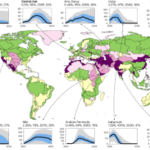2024-04-25 ハーバード大学
<関連情報>
- https://seas.harvard.edu/news/2024/04/warming-arctic-reduces-dust-levels-parts-planet
- https://www.pnas.org/doi/10.1073/pnas.2317444121
北極圏の温暖化によって引き起こされた西アジアと南アジアの塵の減少は、カーボンニュートラルに向けたより強力な砂漠化防止策を必要とする Arctic amplification–induced decline in West and South Asia dust warrants stronger antidesertification toward carbon neutrality
Fan Wang, Yangyang Xu, Piyushkumar N. Patel, +8, and Michael B. McElroy
Proceedings of the National Academy of Sciences Published:March 25, 2024
DOI:https://doi.org/10.1073/pnas.2317444121

Significance
Excessive dust loading threats public health and food security and affects regional and global climate. This study reveals a robust and significant decrease in dust loading across West and South Asia in recent decades, and attributes the long-term trend to the Arctic amplification induced circulation changes due to anthropogenic global warming. These findings raise awareness of potential challenges related to increasing dust loading in this region with global efforts to reach carbon neutrality and thus underscore the importance of local land-based anti-desertification measures in concert with broad climate mitigation strategies.
Abstract
Dust loading in West and South Asia has been a major environmental issue due to its negative effects on air quality, food security, energy supply and public health, as well as on regional and global weather and climate. Yet a robust understanding of its recent changes and future projection remains unclear. On the basis of several high-quality remote sensing products, we detect a consistently decreasing trend of dust loading in West and South Asia over the last two decades. In contrast to previous studies emphasizing the role of local land use changes, here, we attribute the regional dust decline to the continuous intensification of Arctic amplification driven by anthropogenic global warming. Arctic amplification results in anomalous mid-latitude atmospheric circulation, particularly a deepened trough stretching from West Siberia to Northeast India, which inhibits both dust emissions and their downstream transports. Large ensemble climate model simulations further support the dominant role of greenhouse gases induced Arctic amplification in modulating dust loading over West and South Asia. Future projections under different emission scenarios imply potential adverse effects of carbon neutrality in leading to higher regional dust loading and thus highlight the importance of stronger anti-desertification counter-actions such as reforestation and irrigation management.



